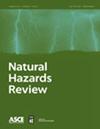Flood Debris Quantification and Comparison Based on the Removal and Disposal Operation: Postdisaster Study of Beaumont, Texas Following Hurricane Harvey
IF 2.2
3区 工程技术
Q3 ENGINEERING, CIVIL
引用次数: 0
Abstract
Accurate forecasts and estimates of disaster debris are critical for effective debris management planning. However, detailed postdisaster waste data to validate and improve debris predictions is often unavailable. In this study, a postdisaster waste dataset collected in Beaumont, Texas, following widespread flooding from Hurricane Harvey that included debris tonnages and coordinate locations of each debris removal in residential areas was investigated. The dataset was utilized to quantify the amount of debris produced, identify the factors that influenced debris generation in different areas of the city, and compare Beaumont debris tonnages to predictive models. The study found that the type of flooding (riverine versus urban) had the highest influence on debris generation. Riverine flooded areas generated twice the debris tonnage as urban flooded areas. Elevation appeared to influence debris generation when considered with the type of flooding. FEMA’s correlation for flooded personal property was within the same magnitude of debris quantities, while other methods significantly overpredicted debris quantities (up to one order of magnitude) due to their generality. However, they can be adapted for flood-generated debris. Urban flooding is an increasingly prevalent issue following a natural hazard and generates considerable amounts of debris, but is not addressed in current disaster management plans. Estimation methods that consider urban flooding should be developed.基于清除和处置操作的洪水碎片量化与比较:德克萨斯州博蒙特市哈维飓风灾后研究
灾害碎片的准确预测和估计对于有效的碎片管理规划至关重要。然而,用于验证和改进碎片预测的详细灾后废物数据往往是不可用的。在本研究中,研究人员调查了哈维飓风造成的大面积洪水后,在德克萨斯州博蒙特收集的灾后废物数据集,其中包括垃圾吨位和居民区每次垃圾清除的坐标位置。该数据集用于量化产生的碎片数量,确定影响城市不同地区碎片产生的因素,并将博蒙特碎片吨位与预测模型进行比较。研究发现,洪水类型(河流与城市)对碎片产生的影响最大。河流淹水地区产生的碎片吨位是城市淹水地区的两倍。当考虑到洪水类型时,海拔似乎会影响碎片的产生。FEMA对被淹个人财产的相关性与碎片数量在同一量级内,而其他方法由于其通用性而明显高估了碎片数量(高达一个数量级)。然而,它们可以适应洪水产生的碎片。城市洪水是自然灾害之后日益普遍的问题,并产生大量的碎片,但在目前的灾害管理计划中没有得到解决。应该开发考虑城市洪水的估算方法。
本文章由计算机程序翻译,如有差异,请以英文原文为准。
求助全文
约1分钟内获得全文
求助全文
来源期刊

Natural Hazards Review
ENGINEERING, CIVIL-GEOSCIENCES, MULTIDISCIPLINARY
CiteScore
4.90
自引率
7.40%
发文量
72
审稿时长
3 months
期刊介绍:
The Natural Hazards Review addresses the range of events, processes, and consequences that occur when natural hazards interact with the physical, social, economic, and engineered dimensions of communities and the people who live, work, and play in them. As these conditions interact and change, the impact on human communities increases in size, scale, and scope. Such interactions necessarily need to be analyzed from an interdisciplinary perspective that includes both social and technical measures. For decision makers, the risk presents the challenge of managing known hazards, but unknown consequences in time of occurrence, scale of impact, and level of disruption in actual communities with limited resources. The journal is dedicated to bringing together the physical, social, and behavioral sciences; engineering; and the regulatory and policy environments to provide a forum for cutting edge, holistic, and cross-disciplinary approaches to anticipating risk, loss, and cost reduction from natural hazards. The journal welcomes rigorous research on the intersection between social and technical systems that advances concepts of resilience within lifeline and infrastructure systems and the organizations that manage them for all hazards. It offers a professional forum for researchers and practitioners working together to publish the results of truly interdisciplinary and partnered approaches to the anticipation of risk, loss reduction, and community resilience. Engineering topics covered include the characterization of hazard forces and the planning, design, construction, maintenance, performance, and use of structures in the physical environment. Social and behavioral sciences topics include analysis of the impact of hazards on communities and the organizations that seek to mitigate and manage response to hazards.
 求助内容:
求助内容: 应助结果提醒方式:
应助结果提醒方式:


